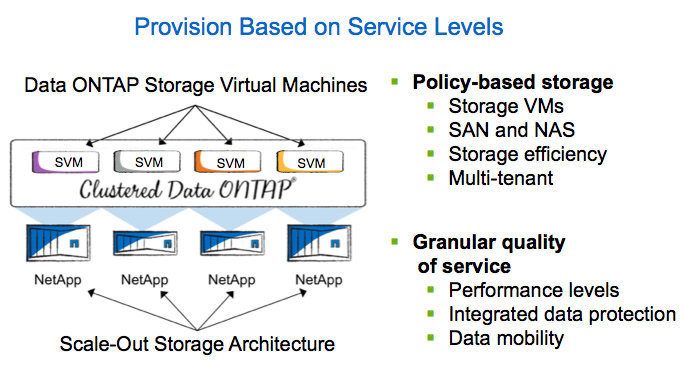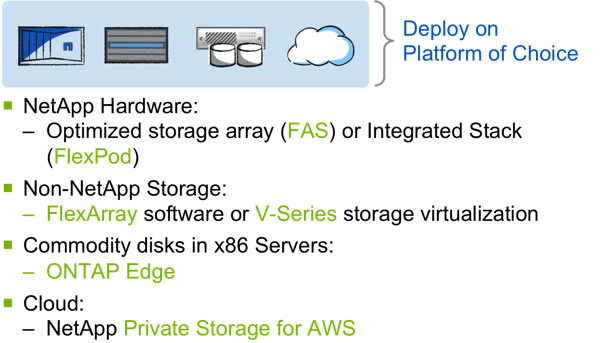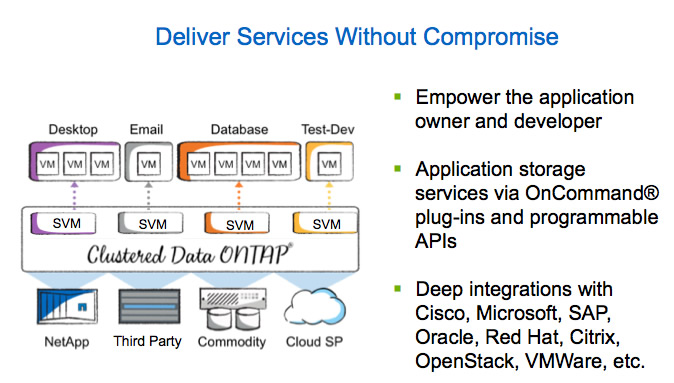


You don't need to spend much time in the IT industry to know that market conversations constantly emerge. Some stick and evolve into actual market drivers (like "cloud" and "big data"), while others fade away (think "information lifecycle management"). I am of the opinion that software-defined data center (SDDC) and software-defined storage (SDS) are solid conversations that are likely to be with us for a while. The "software-defined" industry trend is already influencing IT strategies around the world.
This conversation couldn't be happening at a better time for NetApp, because we just announced clustered Data ONTAP 8.2.1. This release introduces an innovative set of capabilities designed to increase data center agility and accelerate the delivery of storage services to applications and development teams. Because the goals that are emerging for SDS align closely with what has been NetApp's strategic direction for many years, I think you'll see that we are in a unique position to deliver on the promise of SDS.
A Perspective on SDDC

Ideally, IT should operate much more like today's consumer cloud offerings—providing an accelerated rate of service delivery, driving down costs, and decreasing complexity so that it becomes a strategic asset. Imagine the day when requesting a new development environment is as simple as purchasing a new app for your iPad®.
To achieve this goal, IT infrastructures will have to replace the provisioning of hardware in favor of delivering services. Compute, networking, storage, and security have to be virtualized (defined in software) to create a fully automated, policy-enforced, application-driven, software-defined data center.
The NetApp Approach to SDS

NetApp's goal has long been to deliver a high level of storage agility that extends directly to an application or business process. This approach requires us to take a holistic perspective. Consistent with the goals of SDS, the NetApp® technology vision includes:
- Virtualized storage services that provide a dynamic set of capabilities based on virtualized classes of service, not on hardware-defined functionality.
- A broad range of platforms to standardize storage services and access across a set of hardware options to address any budget or deployment model.
- Application self-service that empowers application owners and development teams to consume storage services directly through integrations in native management interfaces and open programmable APIs.
I'll explore each of these areas in a bit more depth.
Virtualized Storage Services

Clustered NetApp Data ONTAP® introduces a new technology for providing storage services via virtualized storage arrays that we call Storage Virtual Machines (SVMs).
Note: We've referred to these as "Vservers" in the past but recently renamed them to eliminate confusion.
An SVM is a logical storage controller that provides storage access for both hosts and end users. It abstracts data access and services from the underlying hardware. All data access in clustered Data ONTAP goes through SVMs; there is no means to directly access storage services from hardware.
SVMs enable some of the cornerstone capabilities in clustered Data ONTAP, including nondisruptive operations and seamless scalability. They also provide the dynamic instantiation of storage services and resource delegation that is critical in an SDS model.

Figure 1) Clustered Data ONTAP virtualizes storage services.
In many ways, SVMs and clustered Data ONTAP behave very similarly to virtual machines and server hypervisors like VMware® and Microsoft® Hyper-V™. They make storage services independent from the underlying hardware, so you can move a storage service or perform hardware maintenance without interrupting applications.
Increased IT Agility
Our SVMs can be configured to use resources from a single storage controller or to use resources from all controllers in a cluster—up to 24 nodes! SVMs can be reconfigured to use more or different resources within a storage cluster without disruption and without having to notify the application owner or reconfigure the application.
Role-Based Access Control and Delegation
SVMs also provide the mechanism for role-based access control (RBAC) and delegation. Because they're abstracted from the hardware, you can assign SVMs to applications, development teams, tenants—even directly to end users—and give them full management over the SVM. From a storage management perspective, you have a clear understanding of what belongs to who, and you can do workload rebalancing—or any task you need to accomplish on the storage side—without impacting the SVMs or the applications they store.
Flexible Storage Services
SVMs allow you to move away from hardware-based provisioning in favor of publishing storage services such as SAN or NAS access, data protection, availability, and performance. New features, like the granular QoS (quality of service) in clustered Data ONTAP, build on the existing set of policies in Data ONTAP that can ensure the delivery of these storage services.
A Broad Range of Platforms

NetApp believes that an essential element of SDS is support for a wide range of storage options, both on premise and in the cloud, with a standardized set of storage services and APIs to access them regardless of the underlying hardware platform. NetApp leads the industry with this initiative, offering Data ONTAP on a wide variety of hardware, including:
- NetApp FAS storage. Our storage-optimized hardware is designed to run clustered Data ONTAP. FAS systems are also available as part of our FlexPod® converged infrastructure platform, co-developed with Cisco.
- NetApp FlexPod Datacenter. Our converged infrastructure platform, FlexPod is co-developed with Cisco.
- Third-party storage arrays. Data ONTAP is available on third-party arrays via FlexArray Software. This gives your existing hardware new storage features and integration capabilities, increasing the value of your previous IT investments.
- Commodity hardware. Data ONTAP Edge was released in June 2012; it enables the commodity disk drives in a server to be virtualized into a shared storage platform in the form of a virtual storage appliance. Today, Edge operates on VMware vSphere®.
- Cloud and cloud service providers. Our most-recognized cloud service offering today is our partnership with Amazon via NetApp Private Storage for Amazon Web Services. This solution offers a new model for those who want dynamic compute, network, and security capabilities, while maintaining data residency and stewardship.
Support for multivendor hardware is really part of our DNA. Over the years, NetApp FAS arrays have shipped with a wide range of CPUs, including MIPS, Alpha, Intel®, and AMD. The ability to run across a diverse set of hardware is one reason why Data ONTAP is the number one deployed storage OS in the world.

Figure 2) NetApp multivendor hardware support.
Application Self-Service

This is probably the area of greatest importance for software-defined data centers; it requires storage services to be directly accessible to applications.
NetApp is widely regarded as an industry leader in this area, providing API integration across the broadest set of technology partners, platforms, applications, and tools. Simply stated, we have more points of integration than any other storage vendor. This helps you to reduce complexity, increase availability, and accelerate the speed of business.Plus, we provide infrastructure that delivers on the promise of automated provisioning – from storage resources to virtual servers and enterprise applications.
Here are just a few of the partners that have integrations at the infrastructure, management, and application layers.

In addition to our partner integrations, we provide a single open set of APIs that is standardized across all platforms that run Data ONTAP. For every command-line capability, we have a matching API. This means that developers can incorporate NetApp functionality into applications and workflows with a single approach that supports every Data ONTAP deployment option.

Figure 3) Application self-service.
Conclusion

Clustered Data ONTAP is the only storage software in the market today that allows storage to be provisioned based on service levels from pooled hardware resources spanning a wide range of platforms, including NetApp optimized, third-party, commodity, and cloud storage. It includes the most comprehensive set of integrations for enterprise applications and a standardized set of open, programmable APIs for workflow automation and application development.
I may be biased—heck, I am biased —but my belief that clustered Data ONTAP is the best storage foundation for a data center is one of the reasons I work at NetApp. The NetApp vision of delivering IT agility will continue to advance with each Data ONTAP release, regardless of whether the terms "software-defined data center" and "software-defined storage" stand the test of time.
Be sure and check out our SDS web page for the latest developments.





